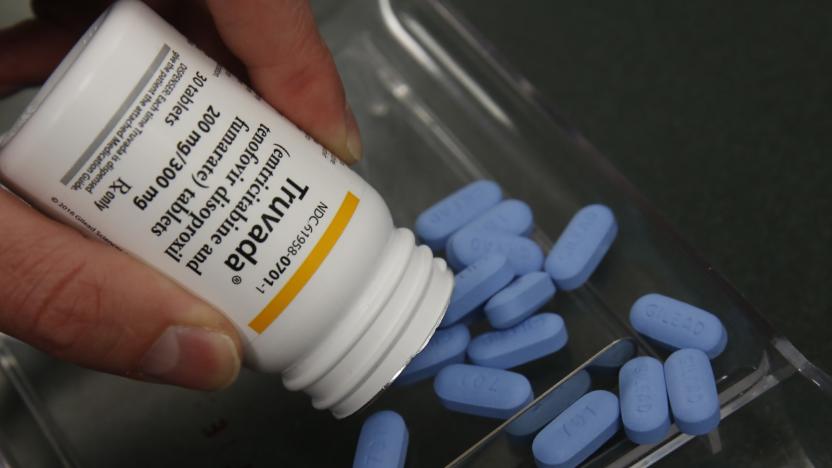drug
Latest

CRISPR-based gene editing therapy approved by the FDA for the first time
The FDA greenlit two new drugs for the treatment of sickle cell disease in patients 12 and older, one of which —Vertex’s drug Casgevy.

Ads on Facebook are spreading misinformation about anti-HIV drugs
While many are focused on Facebook's unwillingness to curb false political ads, there appears to be another misinformation campaign going unchecked. The Guardian and GLAAD have noted that personal injury law firms continue to run Facebook ads making false claims about the risks of Truvada, a drug meant to reduce the likelihood of HIV transmission. Some float the specters of bone loss and kidney damage despite evidence that the risks of either are "not clinically significant," according to the San Francisco AIDS Foundation.

Strawberry-flavored HIV medicine could save thousands of children
There are roughly 80,000 babies and toddlers who die of AIDS every year, and that's partly due to the difficulty of administering the medicine. It can be extremely difficult for a toddler to swallow a pill or a foul-tasting syrup with alcohol. Cipla may have a much better solution. It's introducing a new anti-HIV drug, Quadrimune, whose strawberry-flavored granules are much easier to swallow. While it comes in capsules, parents can make it more palatable by sprinkling the contents on soft food or in drinks.

A generic HIV prevention drug should arrive in 2021
Pharmaceutical giant Gilead has agreed to release its exclusive patent to manufacture and sell the HIV-prevention drug Truvada. This means we could see a generic version of the pre-exposure prophylaxis (or PrEP) on the market earlier than expected. The news is seen as a win for individuals who may be at a greater risk of contracting HIV.

Molecule-level 'CT scans' could lead to faster drug discovery
Scientists like to use x-rays when determining chemical structures to develop drugs, but it's an agonizingly slow process. As they need large, pure crystals, it can take weeks or even years to produce something big enough for studying. However, that time might be cut down to a matter of minutes. Researchers have developed a CT scan-like technique that can quickly and easily detect the shape of very small organic molecules. It borrows elements of the x-ray technique, but doesn't demand the large crystals.

FDA approves its first marijuana-derived drug
In a nationwide first, the US Food and Drug Administration (FDA) has authorized the use of 'Epidiolex', a marijuana derivative which will be used to treat rare forms of epilepsy. Epidiolex -- also known as cannabidiol or CBD -- is a highly-purified version of the many psychoactive compounds found in marijuana, and does not result in a high.

GSK will use supercomputers to develop new drugs
Developing a new drug is a long, complicated and expensive process that takes years before you get to the human trial. There's a hope that computers will be able to simulate the majority of the process, greatly reducing the cost and time involved. That's why GlaxoSmithKline is throwing $43 million in the direction of Scottish AI company Exscientia, which promises to use deep learning to find new drugs.

First gene therapy drug proves a flop in the market
When UniQure launched the first commercial gene therapy drug, Glybera, it promised a minor revolution in medicine. By using custom viruses to deliver genes, it could reportedly cure a rare disease (lipoprotein lipase deficiency) with just one round of treatment. However, it just didn't live up to the early hype. UniQure has announced that it's withdrawing Glybera from the European market when its approval ends on October 25th. The company doesn't beat around the bush with an explanation: the drug's use has been "extremely limited" since going on the market in 2012, and it doesn't expect an uptick in the years ahead. If you know how the drug was sold, though, this inglamorous exit was more of an inevitability than a surprise.

FDA approves a drug made using 3D printing
You might be familiar with the concept of 3D-printed medical equipment, but you're going to have to get used to seeing 3D-printed medicine, too. The US Food and Drug Administration has approved its first drug manufactured using 3D printing, Aprecia's epilepsy-fighting Spritam. The medication uses a porous, 3D-printed formula to help deliver even very high doses (as high as 1,000mg) while remaining easy to swallow -- all you have to do is take a sip of liquid to quickly disperse the drug and get it into your body.

FedEx charged with transporting drugs for illegal online pharmacies
Live animals. Hazardous waste. Used tires. Cash. These are all items that you can't ship via FedEx. Medication is accepted, however, as it poses no risk to the carrier -- or so it seemed. Today, FedEx was indicted in a US District Court, facing criminal charges for its role in providing logistics for illegal online pharmacies. Various US agencies have reportedly been warning FedEx to stop accepting such shipments for years, so as shocking as the charges may seem, they should come as no surprise to executives. If guilty, FedEx would have to hand over the $820 million or so it's earned by transporting drugs such as oxycodone and hydrocodone for black market distributers.

NY medical marijuana law could mean big bucks for vaporizer makers
New York is against second-hand smoke of any kind; even beneficiaries of the state's new medical marijuana law will need to avoid lighting up. Government restrictions do allow vaporizers, however, which got their (legal) start with tobacco and are about to become big business in NY. The handheld devices will play a key role in the treatment of medical marijuana recipients, who will be permitted to inhale the drug through vaporizers, but not by using cigarette paper and a lighter. You'll also be able to consume marijuana in food or through a concentrated liquid called a tincture, but there's no question that vaporizers will become more prolific as more New Yorkers get their hands on closely regulated prescriptions in the days and months to come.

FDA approves Proteus Digital Health's e-pills for dose monitoring
An "ingestible sensor" doesn't sound like the tastiest of snacks, but soon it might be just what the doctor ordered. A tiny microchip which activates upon contact with stomach acid has recently been given the green light by the US FDA. When the sensor is swallowed, an external patch picks up its signal and shoots a message over to whoever it's supposed to. The technology is aimed at tackling an issue known in the healthcare biz as compliance -- or, following instructions. Correct timing and dose are important for many drugs, and lax schedules can be responsible for treatment failures or the development of nasty drug-resistant bugs. Although the pills have only been used in trials, one pharmaceutical heavyweight has already bagged a license to the technology for real-world applications. If you don't like the thought of a belly full of microchips, no need to worry -- the harmless sensors pass naturally after completing their mission.

The Daily Grind: Do narcotics belong in MMOs?
Be it a sci-fi cantina or a fantasy tavern, your MMO's local watering hole no doubt offers a very specific sort of drug: alcohol. But you might have noticed that non-alcoholic drugs aren't usually given the same chance to virtually corrupt you as do more comfortable vices like extreme violence, gore, thievery, and physics-defying cleavage. Immersion-centric players might argue that narcotics add to the gritty realism of many game worlds and aren't really different from other mind-and-body-altering substances like booze, but developers seem wary of wading into that territory. Star Wars Galaxies, for example, launched with canon-correct spice (complete with "downer" effects) but ended spice production with the NGE. And Lord of the Rings Online implemented Tolkien's famous pipeweed but has resisted bestowing beneficial effects on those who smoke it, probably for fear of encouraging "bad" behavior, triggering political drama, or jeopardizing its age rating. What do you think -- do narcotics belong in MMOs? Every morning, the Massively bloggers probe the minds of their readers with deep, thought-provoking questions about that most serious of topics: massively online gaming. We crave your opinions, so grab your caffeinated beverage of choice and chime in on today's Daily Grind!

Inhabitat's Week in Green: Rolls Royce 102EX test drive, electric unicycle and a sun-powered leaf
Each week our friends at Inhabitat recap the week's most interesting green developments and clean tech news for us -- it's the Week in Green. Electric vehicle momentum swept the states this week as Inhabitat took a spin in the new Rolls Royce 102EX Phantom EV, and we brought you exclusive photos of BMW's brand new i3 and i8 electric cars. We also showcased six sexy electric vehicles set to hit the streets in 2012, watched a 350MPG EV win the Future Car Challenge, and saw scientists create the world's smallest electric vehicle from a molecule and four motors. Meanwhile, El Al airlines announced plans to launch a line of hybrid-electric Boeing 737 airplanes, Ryno unveiled a crazy electric unicycle, and a team of students revealed Uganda's first electric car. It was a big week for alternative energy as well as Kenya announced plans to tap lava power with a newly Toshiba-built geothermal energy plant and scientists made a breakthrough in using urine as a viable power source. We also looked into a scientist claiming to have achieved cold fusion, a 'solar cucumber' that harvests fresh drinking water from the ocean, and a sun-powered leaf capable of making ice in the desert. In other news, green textiles advanced by leaps and bounds as scientists wove fabric from 24-karat gold, researchers developed a reusable fabric that administers drugs through the skin, and the University of Kiel's developed a super-adhesive tape inspired by Gecko skin. We also showcased an incredible set of sculptures made from recycled circuit boards, we watched a crop of styrofoam robots invade Germany's streets, and we saw an innovative self-powered irrigation system win the 2011 James Dyson award. And just in time for the chilly winter season, we found these oh-so-handy texting gloves which feature conductive fingertips that allow you to touch, tap, or type on any mobile touchscreen outdoors without having to remove your gloves.

Researchers say nanorockets could deliver medicine quickly within the blood
Faster delivery is always better when it comes to pizza, Thai food and now... drugs? Doctors seem to think so as they're experimenting with a new method of delivering medicine to the bloodstream via tiny nanotubes powered by rocket fuel. By storing healing meds within the platinum-coated metal tubes, doctors have been able to propel the tiny vessels up to 200 times their own length per second -- faster than swimming bacteria. It works as such: by introducing a hydrogen peroxide/water solution, the platinum reacts, sending it zipping forward and catalyzing the peroxide into water and oxygen. The downside? Even though the fuel is only .25 percent peroxide, it's still slightly toxic -- so it looks like it's back to the drawing board until they can develop a safer alternative. Spiders, perhaps? Check out the video demonstration after the break.

Researchers experiment with drug-delivering robot... implanted in an eye
If the notion of a tiny robot swimming around in your eye leaves you a bit uneasy then, well, you might want to stop right here. For the rest of you, though, you may be interested in some new tests now being conducted by Michael Kummer and his team of researchers at the Institute of Robotics and Intelligent Systems in Zurich, Switzerland. What you're looking at above is a pig's eye, and the tiny black spec near the top is a microbot that's able to roam around the eye with the aid of an electromagnetic system. While things are still obviously very early, the researchers say the microbots could eventually be used to precisely deliver drugs in humans, and treat issues like macular degeneration. Head on past the break for the video.

Enzyme found to make fading memories fresher, old wounds painful again
There's something of a saying that you can only remember the things you try to forget, but if you'd prefer to hang on to those photographic moments from Thunder Mountain back in 1991, a gaggle of gurus from the Weizmann Institute of Science just might have the magic elixir you've been yearning for. According to a newly published study on long-term memory revitalization, Reut Shema and colleagues found that boosting the amount of PKMzeta could potentially help one recall memories that were on the brink of being forgotten. In testing, lowering the levels of PKMzeta caused rats to lose track of memories more quickly, but the zany part is that boosting levels on a specific day helped animals recall memories from days prior -- days where they weren't having PKMzeta jacked into their system. Heaven help our legal system should this ever get FDA approval for use in humans.

Zelrix electronic anti-migraine patch heads to the FDA for review
We've seen some electronic devices that promise to cure migraines in the past, but NuPathe's Zelrix patch certainly seems to be among the most practical, and it's just gotten one step closer to the US market. The company recently announced that the FDA has accepted its filing for a New Drug Application, and it says it now has a target date of August 29, 2011 for the FDA to complete its review. As for the patch itself, it's a single-use patch that relies on a mild electrical current to "actively transport" the anti-migraine drug sumatriptan through the skin using a process called iontophoresis. That, NuPathe says, not only allows for a more consistent and controlled delivery of the drug, but it also circumvents the nausea and vomiting that can occur when taking the medication orally -- which the company notes can be enough to cause some folks to avoid taking the medication altogether. Head on past the break for the complete press release.

Drug vending machines start trial in UK, allow awkward videophone conversations with your pharmacist
You've got to imagine the Japanese are green with envy right now, as the BBC report not one, but two different drug vending machines are being tested out under Her Majesty's watchful eye. The first of these experiments is run by supermarket chain Sainsbury's, which has installed a pair of drug dispenser machines in its stores. They identify users by their fingerprint or a unique number, demand PIN verification too, and then finally accept your prescription. Then -- and this is the really silly part -- a pharmacist comes along, picks up your prescription, fills it out, and deposits it in the machine for you to pick up. So it's impersonal and unnecessarily convoluted, great. PharmaTrust seems to have a slightly better idea with its videophone-equipped, ATM-style robo-vendor: it's intended to allow pharmacists to approve prescriptions off-site and out of usual working hours by letting them speak to you via videophone. It could in fact be a big benefit in more remote areas, depending on how patients take to it -- we'll know more when the trial starts up in participating hospitals this winter.

P.L.E.A.S.E. is the polite and painless way to deliver drugs with lasers
Needles? Ouch. Pills? Yuck. Lasers? Awesome! This, we figure, is how a new means of delivering drugs was born. Pantec Biosolutions AG has created a device it calls the Painless Laser Epidermal System, or P.L.E.A.S.E. (We're not sure where the last E comes from, either.) P.L.E.A.S.E. is a means to deliver drugs via laser, effectively blasting tiny holes in your skin through which medication is absorbed, as demonstrated in a soothingly orchestrated video. The process is, apparently, completely painless both for the recipient and the deliverer too, thanks to a fancy touchscreen UI. The device has received marketing authorization, meaning it's able to be sold in Europe, but there is naturally no price or availability listed, so for now you'll just have to take your medicine the old fashioned way.











